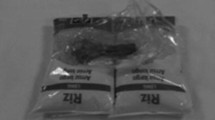Summary. Bone mineralisation during and after limb lengthening procedures on the femur or tibia using unilateral fixators has been monitored quantitatively using dual energy X-ray absorptiometry (DEXA). We measured the bone mineral density (BMD) prospectively in the newly formed callus, in the bone adjacent to the callus and in the proximal femur. In twenty-one patients we showed a typical course with a peak value at 4 – 6 weeks after beginning distraction and a minimum value at maximum distraction. In the consolidation period the BMD in the distraction gap increased until the fixator was removed. The BMD in the regenerated bone increased faster in the regions of interest (ROI) opposite the fixator compared to those near it. Dynamisation caused more homogeneous regeneration equalising V BMD
in the different ROIs. The BMD in the proximal femur of the leg which was operated on decreased to 67% and in the opposite leg to 87% of the preoperative value. DEXA provides a precise and quantitative assessment of callus and bone mineralisation during limb lengthening and helps in understanding what is happening during these procedures.
Résumé. Le processus de la minéralisation peut précisément être étudié d’une manière quantitative pendant et après la distraction du cal au moyen de l’absorptiométrie en énergie-binaire (DEXA) en créant une petite radioexposition. Des patients (n = 21) avec une distraction du cal, auxquels nous avons mesuré prospectivement la densité minérale de l’os (bone mineral density = BMD) dans et autour du cal nouvellement formé, étaient traités avec des fixateurs externes unilatéraux. La minéralisation a montré une courbe typique avec une première pointe de valeur [0,365 +/– 0,196 g/cm 2
(30,9% de la première valeur)] à 4 – 6 semaines après le début de la distraction. Une valeur minimale apparut à la distraction maximale. Dans la période de consolidation la BMD est montèe jusqu’au moment de l’enlèvement du fixateur à 1,020 +/– 0,234 g/cm2 (87%). La minéralisation du cal, mésurée grâce à la technique des «regions of interest (ROIs)», augmenté plus vite aux ROIs éloignées qu’aux ROIs très proches du fixateur. De la dynamisation du fixateur résulte une vitesse de minéralisation plus homogène. Nous considérons la DEXA comme une méthode précise pour étudier les processus de la minéralisation et du développement du cal pendant la distraction avec un fixateur unilatéral. En tenant compte des limites de la technique, la DEXA – qui nous livre des valeurs quantitatives – nous aide à comprendre ce qui se passe pendant la distraction.
Similar content being viewed by others
Author information
Authors and Affiliations
Additional information
Accepted: 11 July 1996
Rights and permissions
About this article
Cite this article
Reiter, A., Sabo, D., Pfeil, J. et al. Quantitative assessment of callus distraction using dual energy X-ray absorptiometry. International Orthopaedics SICOT 21, 35–40 (1997). https://doi.org/10.1007/s002640050114
Issue Date:
DOI: https://doi.org/10.1007/s002640050114




